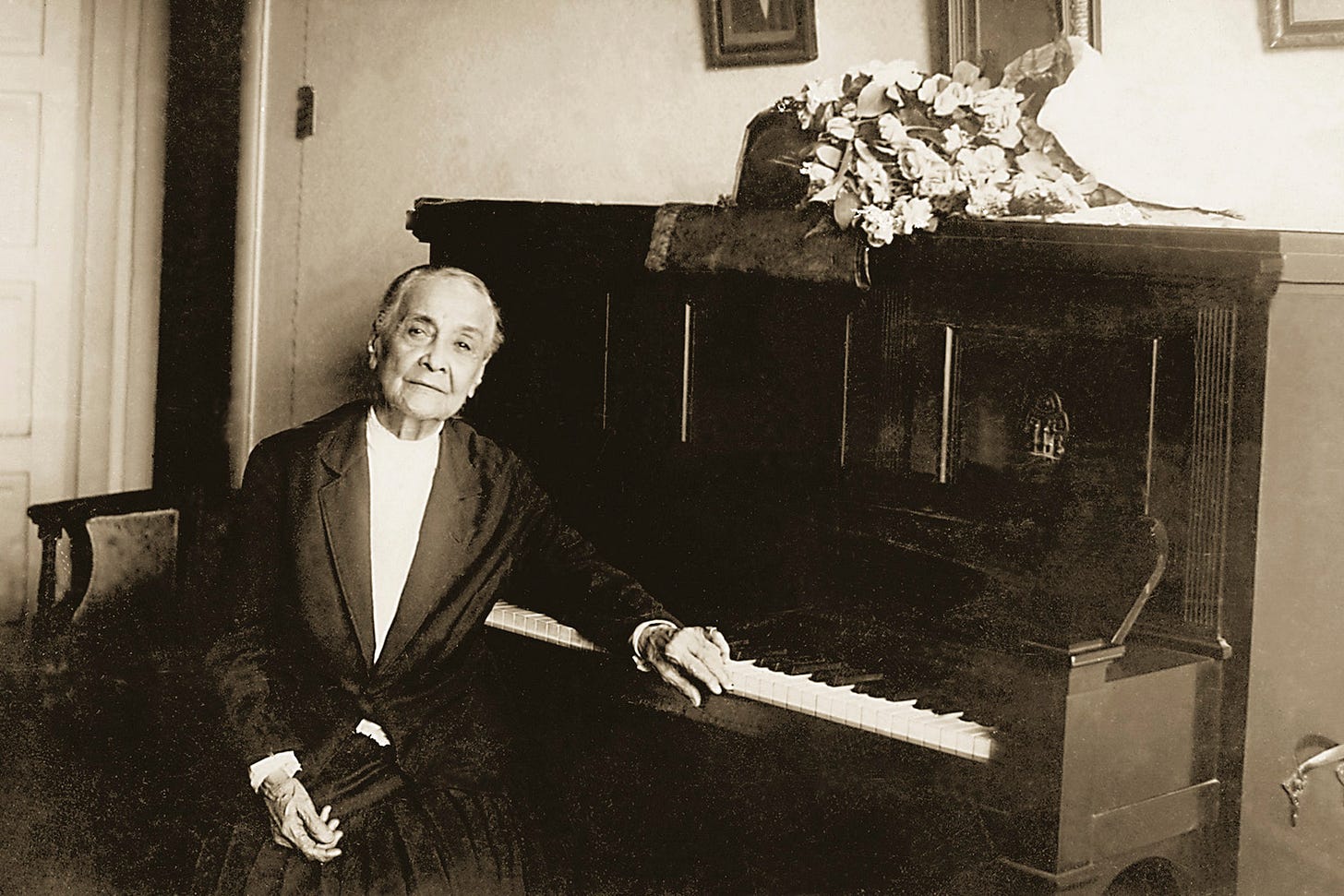Meia Volta #6: Jorge Ben Through Our Lens, Choro Becomes Cultural Heritage, and Brazilian Remakes of International Hits
Painting a Fuller Picture of Brazilian Music
E aí, Brazilian music lovers <3
Co-editors Beatriz Miranda and Ted Somerville here, and we hope you’re doing great!
Welcome to Issue #6 of Meia Volta, the newsletter presenting the nuances of Brazilian music they don’t tell you about 👌
In this issue…
The one and only Jorge Ben through the eyes of Ted, a fun list with our favorite Brazilian remakes and covers of international hits, choro music officially recognized as Brazil’s cultural heritage - and why this matters - and more!
Bora lá? :)
BRAZILIAN MUSIC IN A PHOTO
Jorge Ben by Ted Somerville
While Brazilian music is infinitely vast and diverse, for me personally, at the middle of the entire constellation are Jorge Ben and Elza Soares. Thanks to my best friend playing it for me in high school, Jorge’s masterpiece ‘África Brasil’ was my introduction to Brazilian music, as it is for so many foreigners. To me Jorge embodies and exudes the joyful spirit of Brazilian music, especially Rio de Janeiro’s music, both on his albums and live. He is pure saudade/nostalgia, alegria, charm, affection, and exaltation. I have had the great fortune to see him perform a few times in downtown Rio when he was already in his 70s. Each time he commanded a relentless 3-hour marathon of one party anthem song after another, with the crowd shouting and jumping along, and with no stopping, no intermission. It was an incomparable music high. Now at 84 years old Jorge Ben is the king of Copacabana Palace (yes, he actually resides at the historic hotel) and still performs live with at least a few shows on the horizon this year.
I took the photo during one of his shows at the legendary Circo Voador (The Flying Circus) in 2015 in downtown Rio. Jorge and the band were blazing through the entirety of one of my favorite albums ‘A Banda do Zé Pretinho’. His backing band included some of the phenomenal musicians who’d been recording and playing with him for nearly 50 years at that point. The album cover art of ‘A Banda do Ze Pretinho’ is one of my favorites because of the punchy orange psychedelic pop font, and by pure chance I recently met the son of Hélcio Mário Noguchi, the designer of the album cover while on a shoot near the beach in Rio. Stay tuned for a future interview about Helcio’s prolific career.
By the way, as I am currently in São Paulo, I’ve started asking people who I take portraits of on the street what their favorite Brazilian song of all time is. This past Sunday I was walking the Minhocão (Sampa’s equivalent of New York City’s Highline) and three people in a row responded “Taj Mahal”, Jorge’s major hit from África Brasil, as their favorite. These were people in their twenties and thirties, young enough to be Jorge’s grandchildren. His music is timeless.
Check our Instagram page for more photos from this performance!
BRAZILIAN MUSIC NEWS
On February 29th, Brazil’s Institute of Historical and Artistic Heritage officially declared choro music an intangible cultural heritage of Brazil. More than “just” a music genre or rhythm, choro is above all an aesthetic, or way of playing, that encompasses rhythms like Brazilian tango, maxixe, schottische, and waltz (or “valsa”, in Portuguese).
Considered the first authentically Brazilian urban music culture, choro was born in the late nineteenth century in a rather organic manner. Back then, the streets of Rio de Janeiro were a true cultural cauldron, blending working-class musicians of diverse origins (Jews, Muslims, West Africans, Latin Europeans, among others).
In reunions, these musicians started developing arrangements and harmonic structure that, far from the erudite European tradition, resulted in something completely new.
Among the essential names of the choro world - which, by the way, paved the way for Rio’s urban samba decades later - are Joaquim Callado, Pixinguinha, and Chiquinha Gonzaga. The first woman in choro music, Gonzaga, a pianist, regent, and composer, was also the founder of Brazil’s first copyright institution.
Here’s an article by Beatriz that tells more about women in choro and the legacy of the first authentic urban music of Brazil.
LIST: X FUN BRAZILIAN COVERS OF FOREIGN HITS
And another thing we LOVE about Brazilian music is its genius to create new lyrics and arrangements out of the melodies of foreign hits. We’ve curated some of the most fun (be it because of the lyrics or the arrangements). Enjoy!
Above we have a Spotify playlist for you to listen on the go, and below we provide you the corresponding songs from which the Brazilian songs drew their melodic inspiration.
Pedrinha Morais - “Pi Po Po Po Ro Po” (“Scatman (ski-ba-bop-ba-dop-bop)” by Scatman John)
Sandy e Junior - “Imortal” (“Immortality” by Céline Dion)
Sandy e Junior medley (A Bee Gees pout-pourri)
Rouge - “Ragatanga” ("Aserejé" by Las Ketchup which itself borrows its hook from Sugar Hill Gang’s “Rapper’s Delight”)
Lovezinho - “Tracy” (“Say it Right” by Nelly Furtado)
Golden Boys - “Pensando Nela” (“Bus Stop” by The Hollies)
Gilberto Gil - “Só Chamei Porque Te Amo” (“I Just Called to Say I Love You” - Stevie Wonder)
Ney Matogrosso - "Telma Eu Não Sou Gay" (“Tell Me Once Again” by Light Reflections)
Só Pra Contrariar - "Minha Fantasia" (“Ain’t Over Till It’s Over” by Lenny Kravitz)
Daniel - "Estou Apaixonado" (“Estoy Enamorado” by Donato y Estefano)
Xitaozinho e Xororó - "A Minha Vida" (“My Way” by Frank Sinatra)
Zé Ramalho - "Bate na Porta do Céu" (“Knockin’ on Heaven’s Door” by Bob Dylan)
Dulce Quental - "Natureza Humana" (“Human Nature” by Michael Jackson)
Kaoma - "Chorando Se Foi" (“Llorando Se Fue” by Los Kjarkas)
Rita Lee - "Venenosa" (“Poison Ivy” by The Coasters)
Latino - "Festa no Apê" (“Dragostea Din Tei” by O-Zone)
Fat Family - "Jeito Sexy" (“Shy Guy” by Diana King)
Sidney Magal - "Ah Eu Te Amo" (“Oh Que Je T’Aime”)
Noriel Vilela - "16 Toneladas" (“16 Tons” by Tennessee Ernie Ford)
Kelly Key - "Barbie Girl" (“Barbie Girl” by Aqua)
Andrezin Araujo - Confia em Mim (“All of Me” by John Legend)
Felipe Amorim - "Toca o Trompete" (“Hey Ya!” by Outkast)
Banda Dvaju - "Então Pirei" (“Beat It” by Michael Jackson)
Os Quebradeiras - Faz O Teu Nome (“Lonely” by Akon)
Pablo Vittar - “Pede Pra Eu Ficar” (“Listen to Your Heart” by Roxette)
ON THAT NOTE…
Did you know that Toninho Geraes, a Brazilian composer from the samba scene, is suing the world-famous Adele for plagiarizing one of his original songs?
The Brazilian musician alleges that “Million Years Ago” copied “Mulheres” (Women). According to this Brazilian media outlet, Geraes affirmed that Greg Kurstin, “Million Years Ago” producer and composer, is very acquainted with Brazilian music. Below are both singles for you to compare:
What do you think? Did Adele plagiarize Toninho Geraes or not? Leave us a comment. We are dying to know what you think! 👀
Hope you’ve enjoyed Issue #6! Let us know if you liked it - and see you very soon 💃



